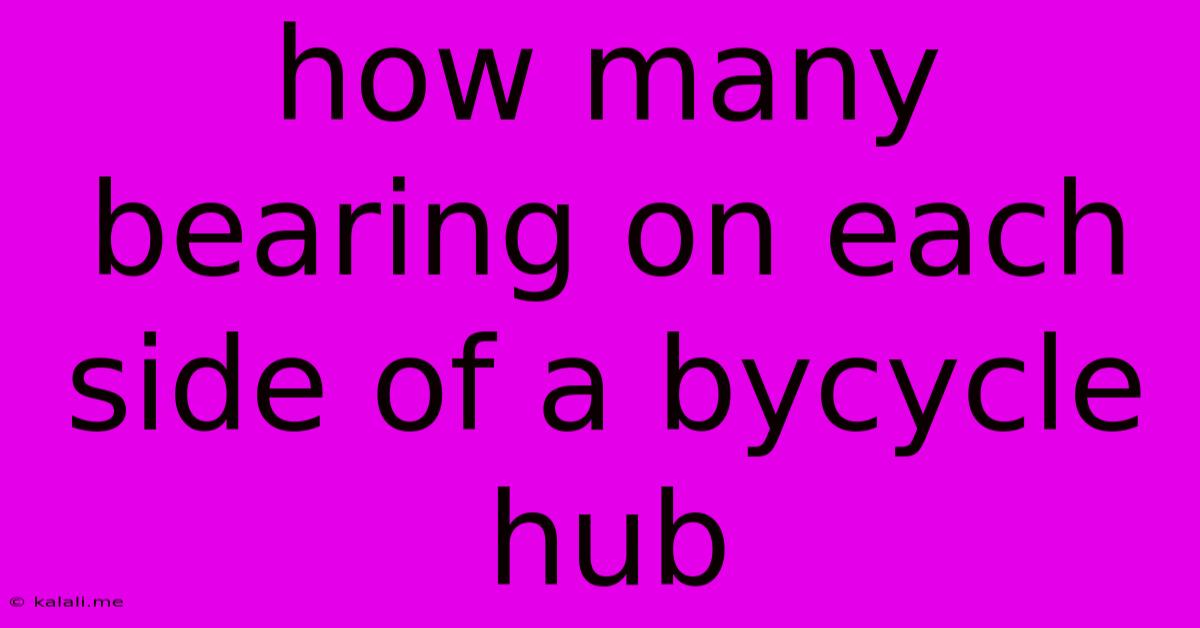How Many Bearing On Each Side Of A Bycycle Hub
Kalali
Jun 02, 2025 · 3 min read

Table of Contents
How Many Bearings Does a Bicycle Hub Have? A Comprehensive Guide
This article will delve into the intricacies of bicycle hub bearings, clarifying the number of bearings typically found on each side and explaining the variations that can occur depending on hub type and design. Understanding your bicycle hub's bearing configuration is crucial for proper maintenance and optimal performance.
Understanding Bicycle Hubs and Their Bearings
Bicycle hubs are the central components connecting the wheels to the frame. They house the bearings that allow the wheels to rotate smoothly and efficiently. The number of bearings per side directly impacts the hub's performance and durability. While there are exceptions, the most common configurations are designed for optimal balance and load distribution.
Standard Configurations: The Typical Number of Bearings
Generally, most bicycle hubs feature two bearings on each side. This arrangement provides robust support for the axle, allowing for smooth rotation under various loads and riding conditions. This is true for both front and rear hubs, although the rear hub often experiences greater stress due to the power transfer from the pedals.
- Front Hubs: Two bearings on each side are standard, ensuring stable wheel rotation and precise steering.
- Rear Hubs: Again, two bearings per side are common, providing ample support for the increased load and forces involved in power transmission.
Variations and Exceptions to the Rule
While the two-bearing-per-side configuration is prevalent, several factors can lead to deviations:
- Hub Design: Some high-end hubs, particularly those designed for extreme riding conditions or weight savings, might employ different bearing arrangements. For instance, some incorporate a single, larger bearing on each side.
- Axle Type: The type of axle used (quick-release, thru-axle) can influence bearing placement and number. Thru-axles often allow for more robust hub designs with varying bearing setups.
- Number of Spokes: While not directly impacting the number of bearings, the spoke count can influence the forces experienced by the hub, thus influencing the type and durability of the bearings. Higher spoke counts generally allow for more even stress distribution.
- Cartridge vs. Loose Bearings: This distinction refers to the type of bearing system used, not the number. Cartridge bearings are pre-assembled units, while loose bearings require more intricate assembly and maintenance.
Identifying Your Hub's Bearings
To determine the exact number and type of bearings in your hubs, you might need to:
- Consult your bike's manual: This often includes detailed specifications about the components.
- Inspect the hub closely: Carefully examine the hub flanges and axle ends to count the bearings.
- Contact your bike shop: A mechanic can quickly assess your hub configuration.
Conclusion: Maintaining Your Hub Bearings
Regardless of the precise number of bearings in your hubs, regular maintenance is essential for optimal performance and longevity. This includes cleaning, lubrication, and timely replacement of worn-out bearings. Proper maintenance will keep your wheels spinning smoothly and extend the life of your bicycle components. Ignoring this can lead to increased friction, reduced efficiency, and ultimately, failure. Remember to consult a bicycle mechanic if you're unsure about performing maintenance yourself.
Latest Posts
Latest Posts
-
If P Then Q Truth Table
Jun 04, 2025
-
How Can You Tell Your Fish Is Pregnant
Jun 04, 2025
-
How To Get Moisture Out Of Headlights
Jun 04, 2025
-
Find The Minimal Polynomial Of A Matrix
Jun 04, 2025
-
Brakes Make Clicking Noise When Pressed
Jun 04, 2025
Related Post
Thank you for visiting our website which covers about How Many Bearing On Each Side Of A Bycycle Hub . We hope the information provided has been useful to you. Feel free to contact us if you have any questions or need further assistance. See you next time and don't miss to bookmark.